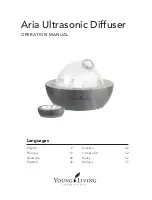
26
User's Guide ADI-6432 © RME
13.3 MADI to MADI Converter
MADI has been used for quite some time now and therefore not all interfaces from different
manufacturers are compatible with each other. An AMS Neve Logic DFC e. g. only accepts the
56 channel input format and when a 64 channel signal is applied, the whole input is muted.
There exist lots of other but similar examples.
The ADI-6432 can serve here as a perfect link, because its MADI input can read any input for-
mat. The ADI-6432's MADI output can be set to 56 channel or 64 channel output mode (see
chapter 8.2). After selecting 96K FRAME there are also 28 or 32 channels in a 96k frame mode.
With this option, the ADI-6432 can translate a double wire MADI signal (2 single speed chan-
nels contain one double speed channel's data) into a single wire double speed signal (1 chan-
nel contains 1 channel's data at double sample rate), or vice-versa.
13.4 AES Inserter
An ADI-6432 can be inserted easily into an existing MADI line. To achieve this simply bridge the
according AES I/Os at the breakout cables, i.e. connect XLR male and female. All 64 channels
then pass the ADI-6432 unchanged.
Specific AES I/Os can now be used to add new signals, or to loop the existing signals through
external devices, thereby processing those signals (for example in effects units). In this applica-
tion the ADI-6432 serves to insert digital devices into the MADI data stream, or as adder of ad-
ditional signals to the not fully utilized MADI data stream.
Example:
A mixing desk sends 48 channels via MADI. 16 more channels from two RME Oc-
taMic-D (8-channel microphone preamp with AES outputs) shall be recorded by a HDSP MADI
into a computer. This application requires one ADI-6432, which has to be inserted into the MADI
line. AES cables are used to pass through channels 1 to 48 from MADI input to MADI output.
The OctaMic-Ds will be connected to the AES inputs 28 to 32. Now the ADI-6432's MADI output
signal includes both the original MADI input channels 1 to 48, and the audio signals of the Oc-
taMics (on channels 49 to 56).
13.5 MADI Merger
Another very interesting application becomes reality when using more than one ADI-6432: com-
bining the audio channels of multiple MADI sources into one single MADI wire. The need for this
application arises quite often, because many devices don't make use of the full channel count.
Often only 32 or 40 channels are used. A HDSP MADI card allows to record 64 channels simul-
taneously into a computer. To also use the remaining channels, further channels have to be
added to the original MADI signal.
Example:
The signals of two MADI devices shall be united to a single MADI stream. This can
be handy, because it requires only one MADI cable for transmission. It can also be a require-
ment, because the receiving device may have only one input.
Summary of Contents for ADI-6432
Page 4: ...4 User s Guide ADI 6432 RME ...
Page 5: ...User s Guide ADI 6432 RME 5 User s Guide ADI 6432 General ...
Page 13: ...User s Guide ADI 6432 RME 13 User s Guide ADI 6432 Usage and Operation ...
Page 25: ...User s Guide ADI 6432 RME 25 ...
Page 28: ...28 User s Guide ADI 6432 RME ...
Page 29: ...User s Guide ADI 6432 RME 29 User s Guide ADI 6432 Technical Reference ...
Page 39: ...User s Guide ADI 6432 RME 39 16 Block Diagram ...
















































